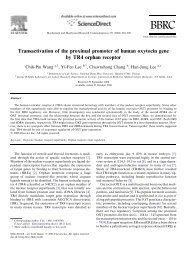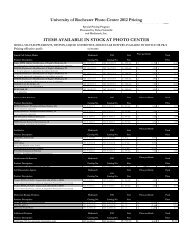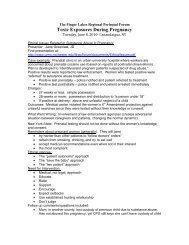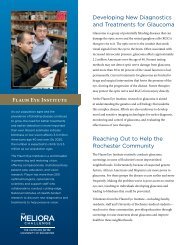Conservative Management of Pelvic Organ Prolapse
Conservative Management of Pelvic Organ Prolapse
Conservative Management of Pelvic Organ Prolapse
Create successful ePaper yourself
Turn your PDF publications into a flip-book with our unique Google optimized e-Paper software.
676 Trowbridge and Fenner<br />
FIGURE 1. Various types <strong>of</strong> pessaries: (A)<br />
ring, (B) Shaatz, (C) Gellhorn, (D) Gellhorn,<br />
(E) ring with support, (F) Gellhorn, (G) Risser,<br />
(H) Smith, (I) tandem cube, (J) cube, (K) Hodge<br />
with knob, (L) Hodge, (M) Gehrung, (N) incontinence<br />
dish with support, (O) donut, (P) incontinence<br />
ring, (Q) incontinence dish, (R) Hodge<br />
with support, and (S) Inflatoball (latex). Photo<br />
courtesy <strong>of</strong> Milex Products, Inc.<br />
recommended that patients, at their initial<br />
fitting, be educated or given written materials<br />
on the possible symptoms and problems that<br />
may arise with the device (Table 3). Patients<br />
who report or anticipate difficulty removing<br />
the device can be taught to tie either dental<br />
floss or mon<strong>of</strong>ilament suture to the pessary<br />
to help with its removal.<br />
TABLE 3. Possible Symptoms and Problems<br />
That May Arise With the Device<br />
• Urinary incontinence<br />
• Slower urine stream<br />
• Difficulty with defecation<br />
• Discharge<br />
• Feeling <strong>of</strong> shifting <strong>of</strong> pessary<br />
• Spotting or bleeding<br />
• Spontaneous expulsion<br />
In this study protocol, after the initial fitting,<br />
patients were asked to come back in 1<br />
to 2 weeks to assess patient satisfaction, possibly<br />
refit the patient with a more comfortable<br />
pessary, or to further educate on selfcare<br />
<strong>of</strong> the device. Specifically, it is important,<br />
at this first follow-up visit, to discuss<br />
comfort, voiding, defecation, discharge,<br />
and ease <strong>of</strong> care for the patient. In the first<br />
year, patients were asked to follow up every<br />
3 months and every 6 months thereafter.<br />
At every follow-up visit, the pessary was<br />
removed, cleansed with water, and speculum<br />
examination performed to evaluate for abrasions<br />
and erosions. No serious complications<br />
were observed in this study sample.<br />
Complications and<br />
Contraindications<br />
Pessary complications are rare occurrences<br />
in medically compliant patients. The most<br />
common complications are pessary expulsion,<br />
urinary incontinence, and rectal pain,<br />
depending on the type <strong>of</strong> pessary. A commonly<br />
experienced symptom <strong>of</strong> pessary<br />
use is vaginal discharge. A study comparing<br />
pessary users with nonusers found that the<br />
presence <strong>of</strong> a foreign body increased the risk<br />
for bacterial vaginosis by 4-fold. 18 If the<br />
patient is symptomatic, bacterial vaginosis<br />
may be treated, but vaginal cultures are<br />
not recommended. Vaginal estrogen is generally<br />
recommended to patients who, at the<br />
time <strong>of</strong> their initial fitting or at subsequent<br />
follow up, are noted to have vaginal atrophy<br />
or areas ulceration or abrasions from pessary<br />
use. Typically, if ulceration occurs, the pessary<br />
is left out and the patient is advised<br />
to use intravaginal estrogen cream daily<br />
(0.5–1.0 g/d) for 2 to 3 weeks. At follow up,<br />
if the ulcerations have healed, the pessary<br />
can be replaced, and it is recommended that<br />
the patient continue to use the vaginal cream<br />
2 to 3 times per week. If ulcerations recur,<br />
despite estrogen therapy, it may be best to<br />
discontinue pessary management and consider<br />
biopsy <strong>of</strong> the site.

















